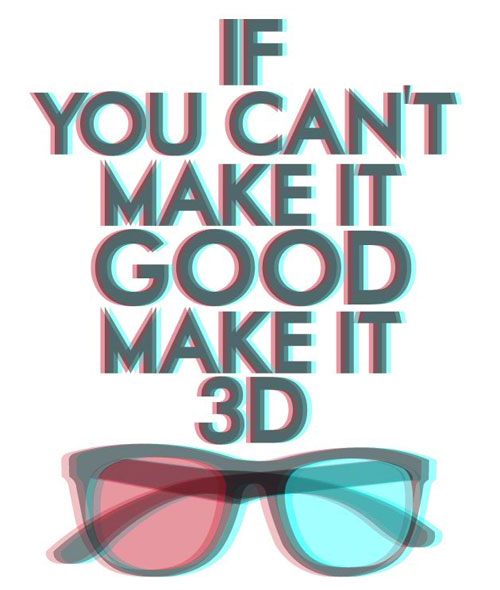3D R.I.P.
It was the last hope for business as usual for the entertainment and consumer electronic industries
Share
 The first (and last) thing that needs to be said about 3D movies themselves is that they aren’t.
The first (and last) thing that needs to be said about 3D movies themselves is that they aren’t.
Three-dimensional, that is. A layer of schmutz floating around a few feet in front of your nose while a movie plays behind it is not a reasonable simulation of our tactile physical universe. We can sit around arguing about the increasing quality of this floating schmutz in the digital age, but schmutz it remains–distracting bits of pollen hovering around our theaters. For a moment it amazes us, and then we struggle (consciously or not) to ignore it so we can focus on the story.
And the story is at the crux of this. 3D advocates point to early resistance to sound and color in the movies as proof that they are on the right track. But sound and color became crucial elements in cinematic storytelling. We’ve yet to see a 3D film where the floating schmutz is integral to the plot, and which could not be understood if you took the goofy glasses off. 3D is a gimmick, and has been since the days of the drive-in.
Poor Hollywood. The industry’s hopes and dreams were pinned to 3D. It was supposed to be a piracy-resistant bit of spectacle that would levitate teenagers out of their basements, away from their Playstations and smartphones and into movie theatres, where they would gladly pay a hefty surcharge on an already hefty ticket price for an “in-your-face” experience. 3D was also supposed to perpetuate the endless consumer gadget cycle, compelling overcompensating dads to ditch last year’s 52 inch HD LCDs for giant 3DTV flatscreens that let them bring the schmutz home. This in turn would propel the next wave of physical media sales, wherein we all would dump our DVD (or Bluray) collections at yard sales, replacing each classic flick with a new edition, digitally upschmutzed to 3D. George Lucas was moist with anticipation!
In short, 3D was the last best hope for business as usual in both the entertainment and consumer electronic industries. A couple of years ago at CES, the massive electronics trade show in Vegas, 3DTVs were everywhere. A couple of years ago, Avatar made Hollywood salivate. But as CES 2012 gears up, the reality is sinking in: Consumers don’t really want 3D at home, and Avatar was a one-off. Sports fans are lukewarm on floating balls, and people feel ridiculous wearing those goofy glasses in well-lit living rooms where they can be seen by their friends and families. Even gamers who bought Nintendo 3Ds are tiring of the optical illusion and turning 3D off.
There are still a few (hundred million) bucks more to be squeezed out of 3D before consumers grow completely sick of the experience, so we will surely see a slew of schmutzy pictures in the months and years to come. And of course, there will be an Avatar 2.
But this thing is on the wane, and Hollywood may soon have to resort to actually producing movies people want to see on account of their content.
Or they could just bring back Smell-O-Vision.
Jesse Brown is the host of TVO.org’s Search Engine podcast. He is on Twitter @jessebrown